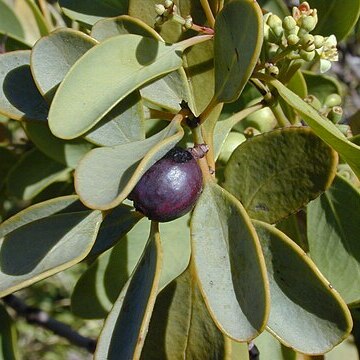Herbs or shrubs, sometimes trees, usually root or stem-hemiparasites, occasionally aerial hemiparasites (Visceae) on stems or branches of the host, bisexual or monoecious or dioecious; glabrous or hairy and the hairs simple or stellate. Haustorium sometimes present (Visceae); haustorial attachment single, epicortical runners absent. Leaves opposite or alternate, rarely whorled, often reduced and scale-like, simple, entire, often soft, sometimes caducous, petiolate; stipules absent. Inflorescence a raceme, spike, panicle, corymb or cluster, often reduced to a single flower, axillary or terminal, usually bracteate, sometimes bracteolate. Flowers actinomorphic, bisexual or unisexual on monoecious or dioecious plants. Perianth usually 1-whorled. Sepals usually absent, or rarely present as a small rim (calyculus) or rarely developed into sepal lobes (e.g. in Buckleya, Osyridocarpos, Thesium libericum, these taxa not in Australia). Petals (2–) 4–5 (–8), rarely more, valvate, free or united into a campanulate or urn-shaped tube. Stamens as many as tepals and opposite them; anthers tetrasporangiate, dithecal or almost so, but often lobed and appearing 4-locular, introrse, dehiscing by longitudinal slits or sometimes by a single apical pore. Gynoecium of 2–5 connate carpels. Ovary inferior, half-inferior or superior, completely unilocular or 1–3-locular basally or 1-locular distally, or the ovary sometimes solid and without differentiated locules. Ovules 1–4 (or ovules sometimes not differentiated); placentation free central. A glandular disc present on top of the ovary, often thickened and lobed at margin, rarely absent; style apical, simple, usually very short; stigma nipple-like or 2-, 3-or 5-lobed. Fruit a nutlet, drupe or pseudodrupe or berries; mesocarp often somewhat fleshy; receptacle often enlarged, fleshy and coloured. Seed 1, without testa; endosperm usually copious.
Herbs, shrubs or trees, hemiparasitic. Leaves often alternate, sometimes opposite, petiolate or sessile, simple, entire, sometimes reduced to scales, exstipulate. Flowers in various sorts of essentially cymose inflorescences, often with a small dichasium axillary to each bract, small, often greenish, hermaphrodite or unisexual (then plants monoecious or dioecious), regular, monochlamydeous, the lobes distinct (in tropical African genera), forming a valvate 3–5-lobed fleshy cup or tube. Stamens as many as and opposite the lobes, inserted at or below their base; anthers (in tropical African genera) with 2 parallel thecae opening by longitudinal slits. Disk epigynous, intrastaminal, lobed, often lining at least the lower part of the perianth tube. Ovary (in tropical African genera) inferior, unilocular; placenta erect, free-central with 2–3 pendulous ovules; style simple, cylindric or sometimes nearly wanting; stigma terminal, capitate or 2–3(–5)-lobed. Fruit indehiscent, dry or fleshy (nut or drupe). Seed solitary; testa obsolete; cotyledons surrounded by copious fleshy, oily or starchy endosperm
Shrubs or trees, root parasites [stem parasites], evergreen or deciduous, synoecious or dioecious [monoecious, andromonoecious]. Leaves opposite [alternate, whorled], simple; stipules absent; petiole present; blade margins entire; venation pinnate. Inflorescences unisexual or bisexual, axillary or terminal, thyrses or umbels [spikes, racemes, cymes, panicles, fascicles], or flowers solitary. Flowers bisexual or unisexual; perianth and androecium perigynous or epigynous; hypanthium adnate to ovary proximally, free distally [completely adnate to ovary]; sepals 0; petals 3–4(–5), distinct, valvate, post-staminal hairs present or absent; nectary present [absent]; stamens 3–4(–5), opposite petals, distinct, free; anthers dehiscing by longitudinal slits; staminodes present in pistillate flowers; pistil 1, 1–3-carpellate, ovary 1/2-inferior or inferior, 1–3-locular proximally, 1-locular distally, placentation free central, pendulous; ovules 2–4 per ovary, anatropous; style 1; stigma 1. Fruits pseudodrupes (mesocarp hard). Seeds 1 per fruit.
Flowers in various sorts of essentially cymose inflorescences, often with a small dichasium axillary to each bract, small, often greenish, hermaphrodite or unisexual (then plants monoecious or dioecious), regular, monochlamydeous, the lobes distinct (in genera of the Flora Zambesiaca area), forming a valvate 3–5-lobed fleshy cup or tube
Ovary (in genera of the Flora Zambesiaca area) inferior, unilocular, placenta erect, free-central with 2–3 pendulous ovules; style simple, cylindric or sometimes nearly wanting; stigma terminal, capitate or 2–3(5)-lobed
Stamens as many as and opposite the lobes, inserted at or below their base; anthers (in genera of the Flora Zambesiaca area) with 2 parallel thecae opening by longitudinal slits
Leaves often alternate, sometimes opposite, petiolate or sessile, simple, entire, sometimes reduced to scales, exstipulate
Stamens the same number as the calyx-lobes and opposite to them; anthers 2-celled, opening lengthwise
Seed solitary; testa obsolete; cotyledons surrounded by copious fleshy, oily or starchy endosperm
Disk epigynous, intrastaminal, lobed, often lining at least the lower part of the perianth tube
Seed without a testa; endosperm copious; embryo straight; cotyledons mostly terete
Calyx often fleshy, adnate to the ovary, lobes 3–6, valvate or slightly imbricate
Leaves alternate or opposite, entire, sometimes reduced to scales, exstipulate
Flowers often greenish, hermaphrodite or unisexual, actinomorphic
Trees, shrubs or herbs, sometimes parasitic on trees or roots
Ovary inferior or half inferior, 1-celled; style simple
Ovules 1–3, pendulous from the top of a basal placenta
Fruit indehiscent, dry or fleshy (nut or drupe)
Herbs, shrubs or trees, hemiparasitic
Fruit nut-like or drupaceous
Disk epigynous
Petals absent

